Sustainability leadership: Aligning action with consumer concerns

When it comes to sustainability leadership, brands have to walk the walk and talk the talk. Not only do consumers demand eco-friendly products, and sustainable best practice from the brands that they buy from – but they also require authentic and transparent communications.
Brands use Relative Insight to analyze company communications in comparison to customer feedback to discover gaps in perception. This form of analysis demonstrates how brands and consumers differ and align with one another when discussing environmental issues.
Relative Insight harnesses the power of contextual understanding through comparison. By comparing one set of words to another, our platform pinpoints the unique topics, words, phrases, grammar and emotion seen from each.
What is sustainability leadership?
I spoke with Dr. Geoff Kendall, the Co-founder and CEO of Future-Fit Business, about the importance of sustainability leadership in achieving net zero emissions. The Future-Fit Business Benchmark provides the framework for brands to better their environmental and human impact on the earth.
Geoff told me that sustainability leadership requires a real commitment to achieving net zero, reducing emissions is simply not enough. He not only emphasized the importance of taking action, but the value of spreading awareness. Sustainability leadership goes beyond a brand’s individual influence and requires a larger advocacy effort.
“What are you going to do to change the system?” He said. “Encouraging or helping suppliers? Educating customers? Companies can exert influence that goes beyond reducing their own impact.”
How do three popular brands tackle this challenge? For this social analysis, we compared online company communications against tweets mentioning the brand over the course of 2021. Here’s what we found:
Patagonia
Tweets
As a longtime sustainability leader, it shouldn’t come as a surprise that feedback relating to Patagonia’s environmental policies was largely positive. Tweets called the company industry leaders – using the words good, great and love to describe sustainability efforts and transparency.
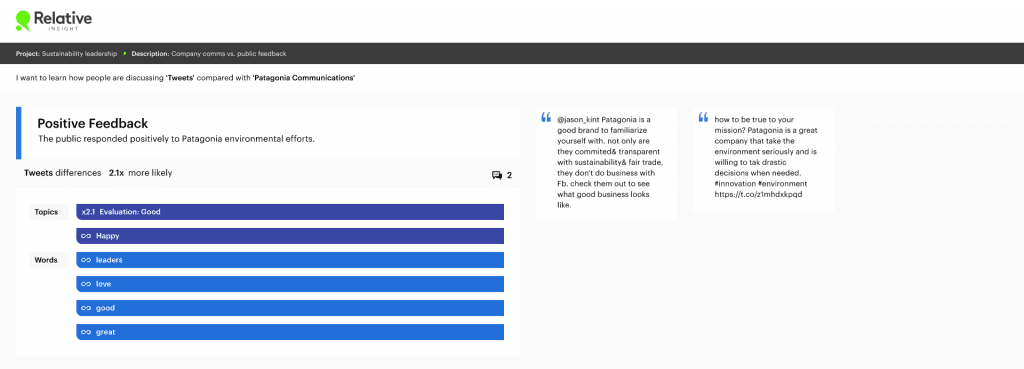

Company communications
This focus on transparency was reflected in Patagonia’s company communications. The brand went beyond general concern for the planet. Patagonia detailed specific actions taken and future goals pertaining to a range of sustainability issues, including fair trade practices, recycled materials, animal and environmental welfare.
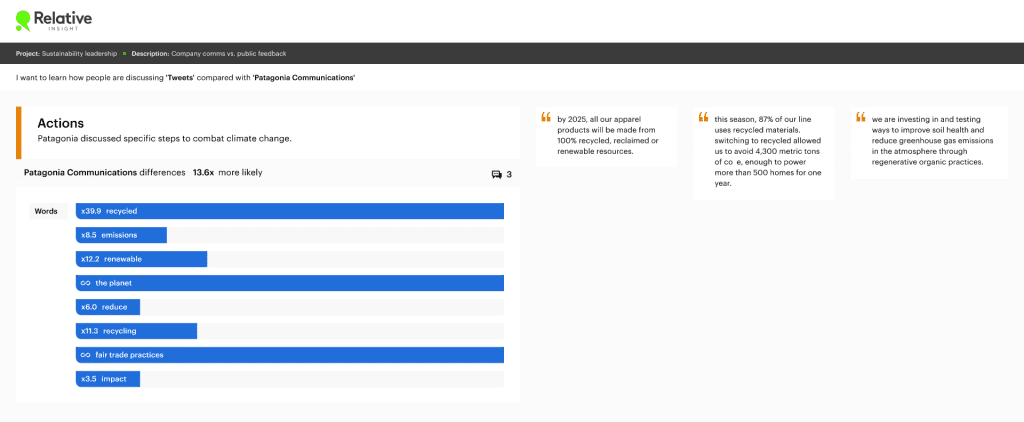

Netflix
Company communications
Whereas Patagonia mentioned multiple areas of action, Netflix had a singular goal. The streaming service communicated a focus on renewable energy and reducing their electrical footprint. As a company without a physical product, Netflix chose to address the environmental issue the company directly impacts.
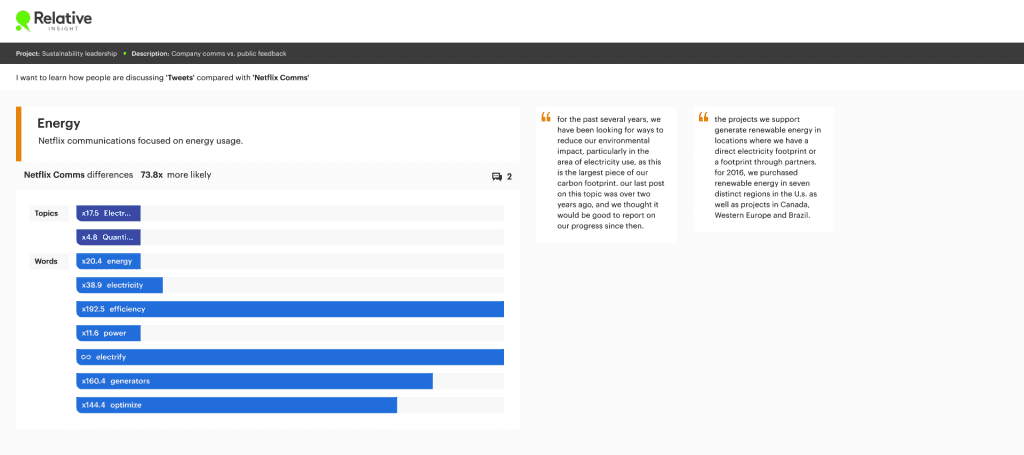

Tweets
Although Netflix has made these sustainability pledges, the public chose to discuss Netflix’s climate-focused shows and movies instead. Recent tweets mentioned Seaspiracy and Don’t Look Up, discussing the movies’ entertainment value in addition to their impact on spreading awareness.
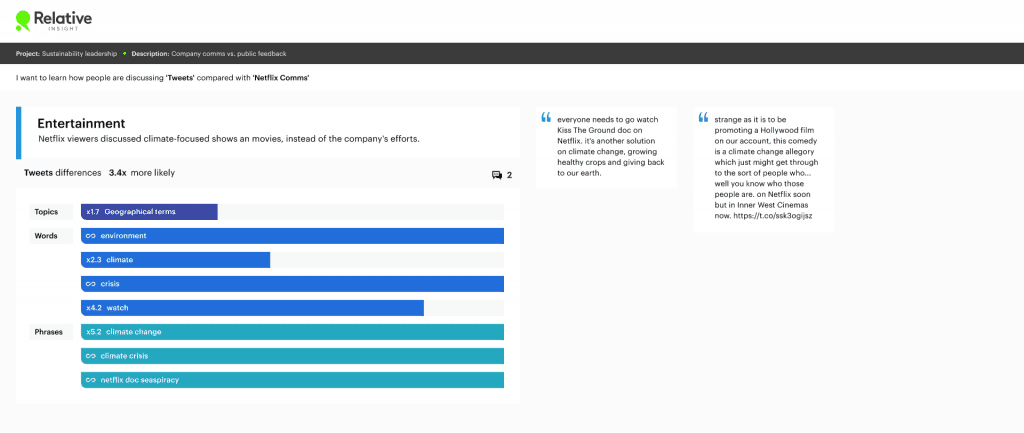

Costco
Company communications
Costco’s environmental focus was on the planet’s ecosystems and habitats. Company communications used words like forest, deforestation, grasslands, and diversity. While the company also discussed other sustainability issues, this finding demonstrates that Costco was more likely to talk about ecosystems than its customers.
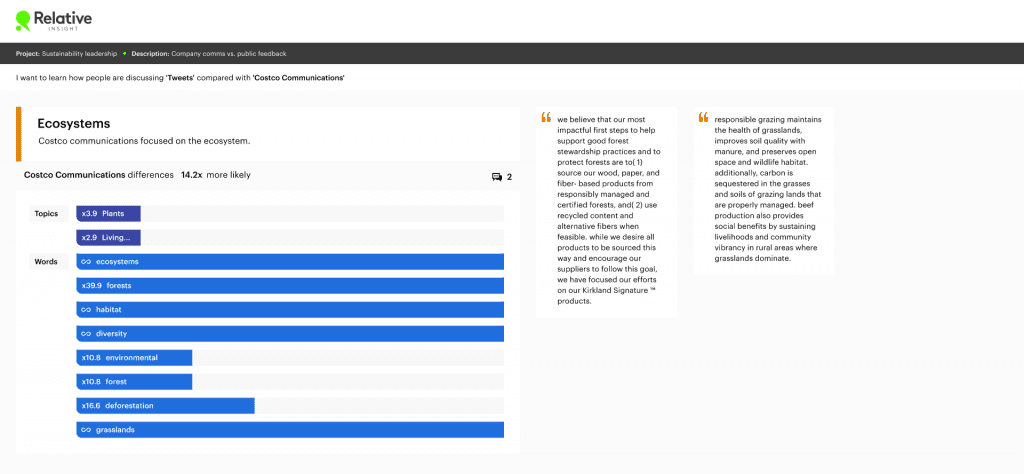

Tweets
Customers, on the other hand, were overwhelmingly concerned with plastic waste – more so than Costco. Tweets used words like plastic, plastics, wasteful and pack when discussing steps the wholesale retailer’s sustainability efforts. This discrepancy in communication could indicate that Costco is not addressing customers’ environmental concerns and priorities.


While each company chose different paths of action and words to communicate their efforts concerning sustainability leadership, brands and customers alike can agree on one thing – we’re not doing enough. Not only can brands address their own negative impact on the earth, they can use their platform to spread awareness and start those important conversations.
Check out our webinar Sustainability: tracking the ever-changing vernacular, where we explored the constant challenge brands face keeping up with the evolving sustainability conversation or our article which explores the differences in political and activist speeches at COP26.
